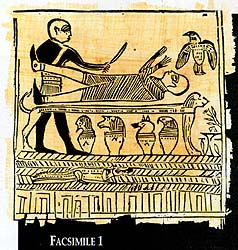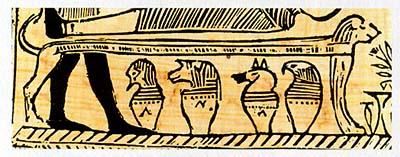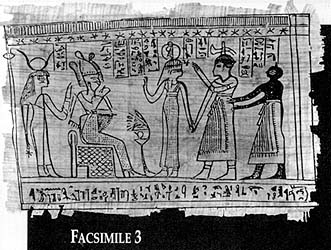“News from Antiquity,” Ensign, Jan. 1994, 16
Old Testament
News from Antiquity
Evidence supporting the book of Abraham continues to turn up in a wide variety of sources.
The book of Abraham occupies a mere fifteen pages in the current English edition of the Pearl of Great Price, including four pages of illustrations and explanations. And yet it offers a wealth of knowledge in its clear teachings about premortal existence and foreordination. Consider, for example, the knowledge of heavenly bodies, of the eternal nature of spirits, and of the great council in heaven—in which the plan of salvation was laid out—all packed into just one chapter, chapter 3.
While a prayerful reading of its few pages allows the Spirit to bear witness to the book of Abraham’s divine origin, the book has often been a focus of criticism for those seeking to find some error in the works of Joseph Smith. And yet as the world’s knowledge of antiquity increases—as scholars probe ancient nonscriptural texts that have come to light during the past 150 years—the book of Abraham receives intriguing support. There is a variety of evidence illuminating this book of scripture given to us through the Prophet.1
Ur of Chaldea
The book begins with Abraham “in the land of Ur, of Chaldea.” (Abr. 1:20.) It is obvious that this “Chaldea” was a place under strong Egyptian influence. It was there that Abraham’s own fathers turned aside from worship of the true God to the service of “the god of Pharaoh, king of Egypt.” (Abr. 1:6; facsimile 1, fig. 9.) Apart from a passing reference in Joshua 24:2, the Bible does not tell of the idolatry of Abraham’s ancestors. However, their worship of false gods and Abraham’s faithfulness in worshipping the true God, as well as his attempts to convert his family, are common themes of many very old Jewish and Christian stories.2
Where was Ur of the Chaldees? Since the nineteenth century, most authorities have identified it with the modern Tell al-Muqayyar, a site in southern Iraq. However, certain elements of the book of Abraham do not seem to fit well in southern Iraq; in particular, Egyptian influences appear to be lacking there during the time of Abraham (traditionally placed around 2000 B.C.). It is thus interesting to note that some recent reevaluations of the question locate Ur in the area known anciently as Aram-Naharaim, or northwestern Mesopotamia (northeastern Syria and southeastern Turkey, in terms of modern geography). This was a region under Egyptian influence at the time of Abraham.3 The book of Abraham mentions a place it calls “the plain of Olishem” (Abr. 1:10), which was apparently part of the land of Chaldea. No such place is mentioned in the Bible, but the name does occur in an inscription of the Akkadian ruler Naram Sin, dating to about 2250 B.C. Remarkably, it refers to a place located precisely in northwestern Syria.4
Facsimile 1

Ancient texts sustain the book of Abraham account that there was indeed an attempt on Abraham’s life (Abraham depicted it in facsimile 1).

They also verify the names of four idols (detail) and confirm the terminology for the “pillars of heaven” (bottom of facsimile).

Facsimile 1 shows “the idolatrous god of Pharaoh,” a symbol of the king, swimming in what the Egyptians conceived as “heavenly ocean,” shown above the “pillars of heaven.”
Ancient texts indicate that the idolatrous gods of Elkenah, Libnah, Mahmackrah, and Korash, described in the book of Abraham (Abr. 1:6, 13, 17; facsimile 1, figs. 5–8), truly were worshipped in the ancient world, despite the fact that the Bible makes no mention of them.5 Furthermore, ancient texts suggest that the ensemble of four figures depicted as figure 6 of Facsimile 2 could indeed “represent this earth in its four quarters” in the ancient world, as the explanation to the facsimile in the book of Abraham says.6 Ancient texts also support the interpretation given in the book of Abraham of figure 11 of facsimile 1 as “designed to represent the pillars of heaven, as understood by the Egyptians.” In fact, the phrase “pillars of heaven” occurs in Egyptian literature.7 The angled lines below the lion couch in facsimile 1 are identified as “the firmament over our heads” (fig. 12), which must seem rather strange to any modern reader. It only makes sense when we realize, in light of recent research, that the lines represent the waves of the water in which the crocodile is swimming, and that one way the ancient Egyptians conceived of heaven was as “a heavenly ocean.”8
One noteworthy element of the religious situation portrayed in the book of Abraham is the identification of a crocodile as “the idolatrous god of Pharaoh.” (Facsimile 1, fig. 9.) Although this may have seemed strange in Joseph Smith’s day, discoveries in other ancient texts confirm this representation. Unas or Wenis, for example, was the last king of the fifth dynasty (circa 2356–2323 B.C.), and his pyramid still stands at Saqqara, south of modern Cairo. Utterance 317 of Unas’s Pyramid Texts includes the following: “The King Appears as the Crocodile-God Sobk,” and “Unas has come today from the overflowing flood; Unas is Sobk, green-plumed, wakeful, alert. … Unas arises as Sobk, son of Neith.”9 One scholar observes that “the god Sobk is … viewed as a manifestation of Horus, the god most closely identified with the kingship of Egypt” during the Egyptian Middle Kingdom era (circa 2040–1640 B.C.), which includes the time period that tradition indicates as Abraham’s lifetime.10
Intriguingly, Middle Kingdom Egypt saw a great deal of activity in the large oasis to the southwest of modern Cairo known as the Faiyum. Crocodiles were common there, and Sobk (or Sobek) was the chief local deity. The last king of the twelfth dynasty, which may include the period of Abraham’s life, even adopted the name of the crocodile god, calling himself Nefru-sobk (“Beautiful is Sobk”), and five pharaohs of the next dynasty, the thirteenth, took the name Sebek-hotpe (“Sobk is content”).
The Sacrifice of Abraham
The book of Abraham tells of an attempt by idolatrous priests to sacrifice the young Abraham. (Abr. 1:7–20; facsimile 1.) Although the Bible says nothing of such an episode, postbiblical literature repeatedly mentions Abraham’s miraculous deliverance from an attempt to kill him.11 Recently a reference has been found in a third-century A.D. Egyptian papyrus which associates the name of Abraham with a lion-couch scene like that in facsimile 1.12
The book of Abraham records that years later, as Abraham is about to enter Egypt, the Lord advises him to conceal the fact that Sarai is his wife and to tell the Egyptians that she is his sister, a term whose broad usage also appropriately identified Sarai. (Abr. 2:22–25.) The Bible records the story of Abraham’s answer but is silent regarding the divine counsel that authorized it. (See Gen. 12:11–20.) However, the Genesis Apocryphon, a document found in this century among the famous Dead Sea Scrolls, agrees with the book of Abraham that the patriarch’s behavior in this matter was divinely ordained.13 And there was good reason: The crocodile-god/king of the Pyramid Texts, cited above, is portrayed as willful and tyrannical. Specifically, he is said to steal wives from their husbands whenever it suits him to do so.14 That is, of course, exactly what Abraham expected the pharaoh to do to Sarai.
Abrahamic Astronomy


Ancient writings support Joseph Smith’s explanation that the four figures above (from figure 6, facsimile 2, right) can depict “this earth in its four quarters.”
The third chapter of the book of Abraham offers a remarkable picture of what might be termed “Abrahamic astronomy.” (Abr. 3:1–17.) The prophet is shown various features of the heavens, including even the great astronomical body Kolob, which “is set nigh unto the throne of God.” (Abr. 3:9.) Recent research indicates that the astronomical model portrayed here fits very well among ancient geocentric (earth-centered) notions.15 It is interesting to note that although nothing in the Genesis account of Abraham’s life suggests that he had any special astronomical interests or knowledge, many postbiblical texts present an image of him that accords with what we are told in the book of Abraham.
The first-century Jewish historian Josephus, for instance, quotes an earlier writer describing Abraham as “a man righteous and great, and skillful in the celestial science.”16 In the Testament of Abraham 9–10, which originated in Egypt and dates to the first or second century A.D., the patriarch is caught up into heaven and given a spectacular view of the earth and all its inhabitants.17 Both the Jubilees, composed in the second century B.C., and the Muslim Qur’an, from the seventh century A.D., portray Abraham as a meditative contemplator of the skies.18

A translation from an ancient source closely matches the Egyptian words found in figures 9 and 10 (detail) of facsimile 2.
The Apocalypse of Abraham, from the first or second century A.D., tells how the patriarch was taken into heaven where, among other things, he beheld “hosts of stars, and the orders they were commanded to carry out, and the elements of earth obeying them.”19 (Compare Abr. 4:14–18.) He was also shown “what is in the heavens, on the earth, in the sea, and in the abyss.”20 This is almost an exact translation of the Egyptian words in the left middle portion of facsimile 2 of the book of Abraham (figures 9 and 10). In the vision recorded in the Apocalypse of Abraham, the prophet is shown “the fullness of the whole world and its circle” in a picture with two sides.21 This description could well apply to facsimile 2 (called a hypocephalus by Egyptologists.)

A number of ancient texts support Joseph Smith’s account, depicted in facsimile 3 from the book of Abraham, that the patriarch taught astronomy in Egypt.
Finally, the tenth-century Muslim scholar al-Tabari tells of a vision in which “the seven heavens were opened to Abraham, up to and including the throne [of God].”22 According to the book of Abraham, the Lord wanted his prophet Abraham to communicate to the Egyptians the astronomical and theological information he had received: “I show these things unto thee before ye go into Egypt, that ye may declare all these words.” (Abr. 3:15.) And, in fact, although the text of the book of Abraham as we currently possess it does not actually continue the story into Egypt, Abraham seems to have fulfilled his divine assignment. Facsimile 3 shows an Egyptian scene with this explanation below: “Abraham is reasoning upon the principles of Astronomy, in the king’s court.” A number of ancient texts support this visual account. Josephus tells of Abraham’s teaching astronomy in Egypt.23 The great Christian historian Eusebius of Caesarea, who lived in the late third and early fourth centuries, preserves an even earlier account in his Praeparatio Evangelica; it has Abraham going to Egypt and there teaching astronomy or astrology both to the priests of Heliopolis and to the Egyptian king himself.24
Creation
The fourth and fifth chapters of the book of Abraham record a vision of the Creation that parallels the account given in Genesis yet differs from it in certain important ways. Here, too, the account of Abraham preserved in the Pearl of Great Price goes beyond the Bible but receives support from sources that Joseph Smith could not possibly have known. Again, for example, the Arab Muslim antiquarian al-Tabari preserves reports that Abraham was granted a vision of the Creation.25 And while it seems quite natural to us—thanks to the book of Abraham—to know of the council in heaven at which the creation of man was planned, that knowledge is not found in the Bible. It is found, though, in several ancient documents, all of which were first published in this century.26
One of the interesting elements of the account of the Creation as it is given in chapters 4 and 5 of Abraham is the use in chapter 4 of the verb to organize, by which we are given to understand that the Gods formed the heavens and the earth out of preexisting materials. (See Abr. 4:1, 12, 14–16, 25, 27.) This flies in the face of centuries of Christian tradition, which insists that God created the universe ex nihilo (i.e., “from nothing”). Once again, however, the book of Abraham finds support in current scholarship. The doctrine of ex nihilo creation simply cannot be found in Genesis or anywhere else in the Bible.27 Ancient Jewish writings teach that God created the universe by giving form to formless matter. It was not until the second century after Christ that Christian thinkers began, under the influence of Greek philosophy, to teach creation ex nihilo, and the doctrine only gradually gained wide acceptance.28
Critics have long attempted to make a case against the book of Abraham. They argue that some ancient texts do not support the book. They point to the fragments of the Joseph Smith papyri that we now possess and claim that since the contents of these papyri bear little obvious relationship to the book of Abraham, the book is a fraud; but Hugh Nibley has made an exhaustive study of these claims and has shown that the papyri we now have were probably not the ones from which Joseph Smith translated the book of Abraham.29 And recent research into ancient texts continues to give firm support for what the Spirit has whispered for over a century and a half—that the book of Abraham is authentic.
Most of us have stared wide-eyed at the fascinating pictures in the book of Abraham and have read with awe this translation by the Prophet Joseph Smith of a record of people and events far distant in time. In addition to the strong testimony of the Spirit, there is now scholarly evidence that these scriptures truly convey ancient teachings about eternity and accurately reflect the antiquity from which they came.
Illustrated by Clark Kelley Price